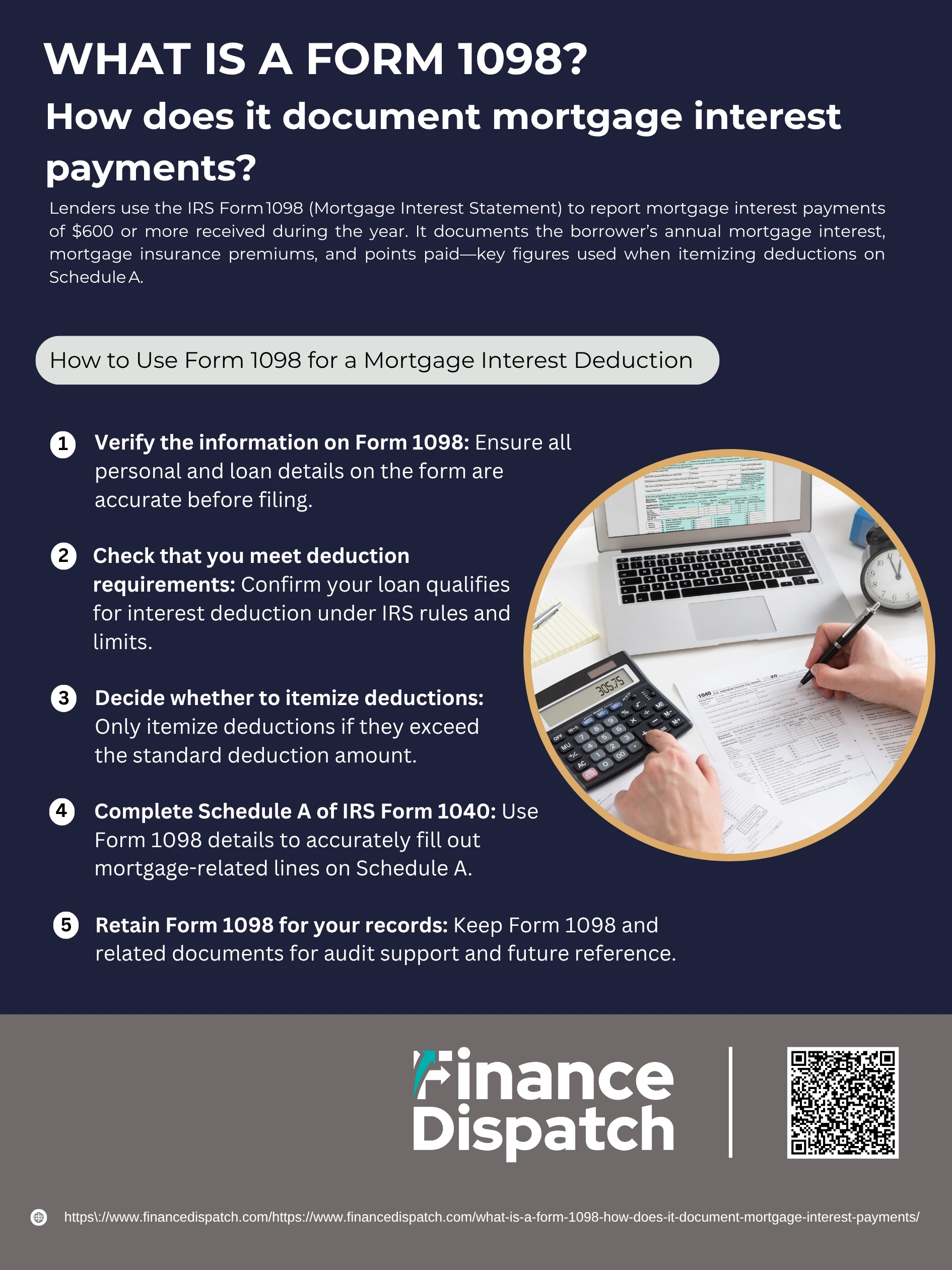When tax season arrives, homeowners may find a Form 1098 in their mailbox or online account from their mortgage lender. Officially titled the Mortgage Interest Statement, Form 1098 plays a key role in helping borrowers claim deductions for mortgage interest paid during the year. If you paid $600 or more in mortgage interest, mortgage insurance premiums, or points, this form documents those amounts and provides the information both to you and the IRS. Understanding what Form 1098 is—and how it records these payments—can help you maximize your tax deductions and ensure accurate reporting on your return.
What Is Form 1098?
Form 1098, officially known as the Mortgage Interest Statement, is a tax document that lenders are required to send to borrowers who have paid $600 or more in mortgage interest during a tax year. It serves as an informational return that details how much interest, mortgage insurance premiums, and points were paid on a qualified mortgage. The form is issued by the lender to both the borrower and the IRS, making it an essential record for homeowners who plan to itemize deductions on their tax return. Whether it’s a primary residence, second home, or even certain types of foreign properties, Form 1098 helps taxpayers determine how much of their mortgage-related expenses may be deductible under current tax laws.
Key Information Reported on Form 1098
Form 1098 contains several important pieces of information that are critical for taxpayers looking to claim the mortgage interest deduction. Each box on the form provides specific data about your mortgage loan, including the amount of interest paid, loan details, and information about the property. Understanding what each field represents will help you report your deductions accurately and avoid potential issues with the IRS.
Here are the key details typically reported on Form 1098:
1. Box 1: Total mortgage interest received from the borrower during the year
2. Box 2: Outstanding mortgage principal as of January 1
3. Box 3: Mortgage origination date (when the loan began)
4. Box 4: Refund of overpaid interest, if applicable
5. Box 5: Mortgage insurance premiums paid during the year
6. Box 6: Points paid on the purchase of a principal residence
7. Box 7: Indicator if the property securing the mortgage is also the borrower’s address
8. Box 8: Address or legal description of the property
9. Box 9: Number of properties securing the mortgage
10. Box 10: Other amounts such as real estate taxes paid from escrow (if reported)
11. Box 11: Date the lender acquired the mortgage during the calendar year (if applicable)
 How to Use Form 1098 for a Mortgage Interest Deduction
How to Use Form 1098 for a Mortgage Interest Deduction
If you’re a homeowner who paid $600 or more in mortgage interest during the year, your lender is required to send you Form 1098. This form contains all the details you need to determine how much of that interest may be deductible when filing your federal tax return. However, in order to claim this deduction, you must itemize your deductions instead of taking the standard deduction. Here’s a detailed step-by-step guide to help you use Form 1098 properly for a mortgage interest deduction:
1. Verify the information on Form 1098
Before using the form for your tax filing, double-check that all the information is accurate. This includes your name, Social Security number, address, mortgage account number, and the figures listed in each box. Any errors—such as an incorrect interest amount or loan origination date—should be corrected by contacting your lender immediately.
2. Check that you meet deduction requirements
The IRS allows you to deduct mortgage interest only if your loan is secured by a qualified home (primary or secondary residence), and the borrowed funds were used to buy, build, or significantly improve that property. Also, you must be legally obligated to repay the loan. There are also limits: for mortgages taken after December 15, 2017, you can deduct interest on up to $750,000 of debt ($375,000 if married filing separately). Older loans may be grandfathered into the previous $1 million limit.
3. Decide whether to itemize deductions
Mortgage interest can only be deducted if you itemize your deductions on Schedule A of Form 1040. Compare your total itemized deductions—including mortgage interest, state and local taxes (up to $10,000), charitable contributions, and qualified medical expenses—with the standard deduction ($15,000 for single filers, $30,000 for married filing jointly in 2025). Itemizing only makes sense if your total deductions exceed the standard amount.
4. Complete Schedule A of IRS Form 1040
Use the information from Form 1098 to fill out Schedule A:
- Line 8a: Enter the amount of mortgage interest reported in Box 1 of Form 1098.
- Line 8b: Enter any deductible mortgage interest not reported on a Form 1098, such as interest paid to a private lender.
- Line 8c: Enter any deductible points you paid that were not included in Box 6 of Form 1098.
This step ensures that your mortgage interest deduction is properly documented and applied to your total itemized deductions.
5. Retain Form 1098 for your records
While you don’t need to submit Form 1098 with your tax return, it’s important to keep a copy for your records. The IRS receives the same information from your lender, but having the form on hand helps in case of questions or an audit. It’s a good idea to keep related documents like closing statements, refinance agreements, and year-end mortgage statements as supporting documentation.
Special Use Cases for Form 1098
While Form 1098 is most commonly associated with homeowners claiming a mortgage interest deduction on their primary residence, there are several other scenarios where the form plays a critical role. These special use cases involve rental properties, vacation homes, mixed-use properties, and even foreign real estate. Each situation has specific IRS rules on how the interest should be reported and deducted, depending on the property’s purpose and usage during the tax year.
Here are some notable special use cases for Form 1098:
1. Rental Properties
Mortgage interest for rental properties is not reported on Schedule A but instead on Schedule E as a rental expense. This applies to interest reported on Form 1098 and may include amortized points over the life of the loan.
2. Mixed-Use Properties
If part of your property is used for personal purposes and part is rented out (e.g., a duplex or basement rental), you must allocate mortgage interest between Schedule A (personal) and Schedule E (rental) based on usage percentages.
3. Vacation Homes
If you own a vacation home, mortgage interest is deductible on Schedule A—as long as the home is not rented out for more than 14 days. If rented longer, deductions must be prorated based on days of personal versus rental use.
4. Foreign Properties
U.S. taxpayers can deduct mortgage interest on foreign homes, as long as the property qualifies as a main or second home under IRS rules. However, Form 1098 is not issued by foreign lenders, so borrowers must obtain equivalent documentation and convert amounts to U.S. dollars.
5. Home Equity Loans and Lines of Credit (HELOCs)
Interest on HELOCs is deductible only if the funds were used to buy, build, or substantially improve the home securing the loan. The interest must be reported using Form 1098 if it meets the $600 threshold.
6. Refinanced Mortgages
If you refinance your mortgage, the new lender should issue a separate Form 1098. Interest on the refinanced loan is deductible, and points paid may be amortized unless used to buy your main home.
Other Types of Form 1098
While Form 1098 is best known for reporting mortgage interest, the IRS has introduced several variations of this form to capture other potentially deductible payments. Each type of Form 1098 corresponds to a specific financial activity—such as student loan interest, tuition payments, or vehicle donations—that may qualify for tax deductions or credits. Understanding these variations helps taxpayers take full advantage of all eligible benefits when filing their returns.
Here is a comparison of the different types of Form 1098:
| Form | Purpose | Issued By | Used For |
| 1098 | Reports mortgage interest, points, and insurance premiums | Mortgage lenders | Mortgage interest deduction on Schedule A |
| 1098-E | Reports student loan interest paid | Student loan servicers | Deduction up to $2,500 as an adjustment to income |
| 1098-T | Reports tuition and related educational expenses | Colleges and universities | Education credits like the American Opportunity Credit or Lifetime Learning Credit |
| 1098-C | Reports donations of vehicles, boats, or airplanes | Qualified charitable organizations | Deduction for charitable contributions if value exceeds $500 |
| 1098-MA | Reports mortgage assistance payments | State housing agencies (HFA) | Adjusts mortgage interest deduction for assistance received |
Common Mistakes to Avoid in Form 1098
Form 1098 can be a valuable tool for reducing your tax liability, but using it incorrectly may lead to missed deductions, IRS notices, or audit triggers. Whether you’re filing taxes yourself or working with a professional, it’s important to avoid common errors that can affect how mortgage interest and related payments are reported. By staying aware of these mistakes, you can ensure a smoother and more accurate tax filing process.
Here are some common mistakes to watch out for when dealing with Form 1098:
1. Failing to Itemize Deductions
Mortgage interest can only be deducted if you itemize. Taking the standard deduction instead may prevent you from benefiting, even if you qualify.
2. Claiming Interest on Non-Qualified Property
Only interest on loans secured by a main or second home qualifies. Interest on personal loans or investment properties (unless reported on Schedule E) is not deductible on Schedule A.
3. Misreporting Amounts from the Wrong Boxes
Confusing Box 1 (mortgage interest) with Box 5 (mortgage insurance) or Box 6 (points paid) can lead to incorrect deductions.
4. Overlooking Points Paid at Closing
Points paid when purchasing or refinancing may be deductible, but many taxpayers forget to include them or misapply amortization rules.
5. Ignoring Refinancing Rules
If you refinanced your mortgage, only interest related to the original loan amount is fully deductible. Interest on cash-out portions must be used for home improvements to qualify.
6. Using Inconsistent Currency for Foreign Mortgages
For foreign properties, failing to convert interest paid into U.S. dollars using IRS-acceptable exchange rates can result in inaccurate reporting.
7. Claiming Rental Property Interest on Schedule A
Mortgage interest for rental properties must be claimed on Schedule E, not as a personal deduction on Schedule A.
8. Not Keeping Supporting Documentation
If your lender doesn’t issue a Form 1098 (e.g., private or foreign lender), you must keep alternative records showing interest paid, property details, and payment dates.
Conclusion
Form 1098 is more than just a year-end tax document—it’s a key to unlocking valuable deductions that can significantly reduce your taxable income. Whether you’re a homeowner, a student loan borrower, or someone who made a charitable donation, understanding how to interpret and use the various types of Form 1098 can help you file your taxes accurately and take advantage of every deduction you’re entitled to. By verifying your information, knowing where to report it, and avoiding common mistakes, you can ensure that your Form 1098 works in your favor when it’s time to file your return.



